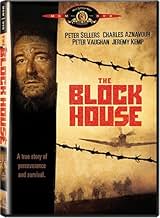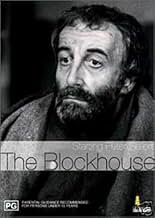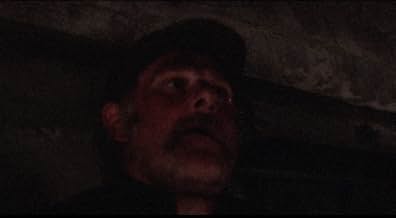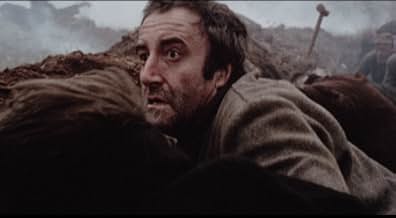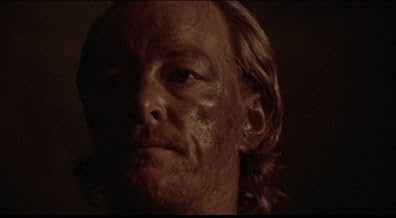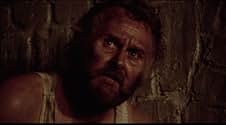अपनी भाषा में प्लॉट जोड़ेंDuring D-day several people become trapped while hiding in a bunker, when heavy shelling collapses it. They have plenty of food and water so they decide to wait for rescuers. And so they wai... सभी पढ़ेंDuring D-day several people become trapped while hiding in a bunker, when heavy shelling collapses it. They have plenty of food and water so they decide to wait for rescuers. And so they wait year, after year, after year.During D-day several people become trapped while hiding in a bunker, when heavy shelling collapses it. They have plenty of food and water so they decide to wait for rescuers. And so they wait year, after year, after year.
- पुरस्कार
- कुल 1 नामांकन
फ़ीचर्ड समीक्षाएं
Talking Pictures TV does it again, they unearth a lost obscurity from the dusty cabinet of film. This time it's The Blockhouse, from 1973 starring Peter Sellers, I use that term loosely because it's a wonderful ensemble piece, in which actors share the screen, dialogue and drama the same. The premise of the movie is a work party of 7 POWs, country of origin indeterminate in occupied Europe. Flee the onslaught of allied bombing on D Day and their German guards by hiding in an underground bunker, on the entrance being bomb and blocked they have to hide further in the catacombs, with no way out they have to live on the contents of the cellar, which is wines, canned foods, cigars, etc etc in fact everything you could possibly want....over the hour and half we watch the men slow descent into madness and their long lingering death, due to the lack of fresh food, fresh air and light. It is so bleak, Sellers, Charles Aznavour, Jeremy Kemp and all are stunning and when you see the outcome and realise it's a true story it will leave a lasting impression.
10carver76
I consider myself as big a Peter Sellers fan as there is in the world, but this one film had eluded me for years until now...It is one of my favorite of Sellers' performances, and is a very powerful film overall. Highly recommended!
A film that seems intended to drive its audience to mass suicide, "The Blockhouse" is more likely to inspire tedium and finally relief when it limps to its unsatisfying conclusion.
The film features seven slave laborers in World War II France who find themselves trapped deep in an underground chamber when their German position is bombed and shelled in preparation for D-Day. There is no escape for these men; they must bide their time eating and drinking from the ample provisions left by the German Army, do their best not to get on each other's nerves, and hope for a miracle.
The film stars Peter Sellers, though he is only a first among equals here and certainly not to be watched for his comic prowess. Playing a teacher named Rouquet, he has a light moment trying to teach dominos to the others, but for the most part stares bleakly at the walls as a heavy beard grows on his face. Sellers is completely convincing in his part, but it is less a character than a construct. Rouquet is the voice of hope whose point in the story is being stilled.
The other main character, and the only one that catches your notice, is Jeremy Kemp's Grabinski, a rational man who realizes before anyone else the hopelessness of the situation but who tries to make things bearable for his comrades. His exchanges with Rouquet playing games reflects the hope/no hope dichotomy.
"I think you'll lose," Grabinski tells Roquet during the dominos demonstration.
"How can you possibly tell I'll lose when I'm teaching you this game?" Roquet replies.
"Never mind," Grabinski shrugs.
The whole movie is like that, unconnected vignettes between the trapped men that strive at some greater purpose without advancing anything resembling a plot. Director/co-writer Clive Rees seems to be trying to go for a Pinder or Beckett thing with the sparse dialogue and hopeless situation. But too much bleakness keeps us distant from the characters and their situation.
As calamities pile up, like the suicide of one of the men and the arrival of winter, it's all you can do to register their pain. You don't have any sense of who these people might be, however good a job Kemp, Sellers, and the other actors do. And they do good work all around, including the legendary French singer Charles Aznavour as a tough scrapper named Visconti and Swedish notable Per Oscarsson as the brooding Lund. With their beards and grimy faces, and their believable, seemingly improvised acting, they pull you into their horrible situation easily enough. But the film lets them down in terms of having anything more to say than life is hell.
Don't be fooled by the 90-minute running time: This is a long movie to sit through, tough to follow with choppy editing that seems to kill off one character twice while two others disappear without explanation. Characters say little to one another, and when they do speak it is often pitched so low one can barely hear it. The visual design leans heavily on the dark surroundings to the point where the only print available today screens like an oil spill.
This is a movie I wouldn't watch once if it wasn't for Sellers, and can't recommend even to his fans. If you like bleak movies, you may feel otherwise, but whatever your mindset I doubt you will have any more success figuring out what is happening than I did.
The film features seven slave laborers in World War II France who find themselves trapped deep in an underground chamber when their German position is bombed and shelled in preparation for D-Day. There is no escape for these men; they must bide their time eating and drinking from the ample provisions left by the German Army, do their best not to get on each other's nerves, and hope for a miracle.
The film stars Peter Sellers, though he is only a first among equals here and certainly not to be watched for his comic prowess. Playing a teacher named Rouquet, he has a light moment trying to teach dominos to the others, but for the most part stares bleakly at the walls as a heavy beard grows on his face. Sellers is completely convincing in his part, but it is less a character than a construct. Rouquet is the voice of hope whose point in the story is being stilled.
The other main character, and the only one that catches your notice, is Jeremy Kemp's Grabinski, a rational man who realizes before anyone else the hopelessness of the situation but who tries to make things bearable for his comrades. His exchanges with Rouquet playing games reflects the hope/no hope dichotomy.
"I think you'll lose," Grabinski tells Roquet during the dominos demonstration.
"How can you possibly tell I'll lose when I'm teaching you this game?" Roquet replies.
"Never mind," Grabinski shrugs.
The whole movie is like that, unconnected vignettes between the trapped men that strive at some greater purpose without advancing anything resembling a plot. Director/co-writer Clive Rees seems to be trying to go for a Pinder or Beckett thing with the sparse dialogue and hopeless situation. But too much bleakness keeps us distant from the characters and their situation.
As calamities pile up, like the suicide of one of the men and the arrival of winter, it's all you can do to register their pain. You don't have any sense of who these people might be, however good a job Kemp, Sellers, and the other actors do. And they do good work all around, including the legendary French singer Charles Aznavour as a tough scrapper named Visconti and Swedish notable Per Oscarsson as the brooding Lund. With their beards and grimy faces, and their believable, seemingly improvised acting, they pull you into their horrible situation easily enough. But the film lets them down in terms of having anything more to say than life is hell.
Don't be fooled by the 90-minute running time: This is a long movie to sit through, tough to follow with choppy editing that seems to kill off one character twice while two others disappear without explanation. Characters say little to one another, and when they do speak it is often pitched so low one can barely hear it. The visual design leans heavily on the dark surroundings to the point where the only print available today screens like an oil spill.
This is a movie I wouldn't watch once if it wasn't for Sellers, and can't recommend even to his fans. If you like bleak movies, you may feel otherwise, but whatever your mindset I doubt you will have any more success figuring out what is happening than I did.
We're told in the opening credits that this is a true story and only two out of seven survive. We then move into a superb opening sequence of Allied bombing, which takes us neatly into the central story of trapped men.
The cast is excellent and the dark, gloomy and claustrophobic atmosphere is well done but, for me, the characters are insufficiently well-drawn. We are told very little about their background and how they arrived at this place. The sound recording leaves something to be desired and the dialogue is often unclear.
Having said that, this is a film which will stay with you, if you make the substantial effort required to watch it. As Sellers has said. "It's a film for connoisseurs of cinema. A very heavy movie, which could easily put you on a downer". My advice though is to make that effort.
One point of fact: the true story was actually one of seven German soldiers trapped in a food depot in Poland, blocked in, unknowingly, by their retreating comrades who dynamite the entrance.
The cast is excellent and the dark, gloomy and claustrophobic atmosphere is well done but, for me, the characters are insufficiently well-drawn. We are told very little about their background and how they arrived at this place. The sound recording leaves something to be desired and the dialogue is often unclear.
Having said that, this is a film which will stay with you, if you make the substantial effort required to watch it. As Sellers has said. "It's a film for connoisseurs of cinema. A very heavy movie, which could easily put you on a downer". My advice though is to make that effort.
One point of fact: the true story was actually one of seven German soldiers trapped in a food depot in Poland, blocked in, unknowingly, by their retreating comrades who dynamite the entrance.
This film could have been a masterpiece as the cast was great and the story was moving.Peter Sellers gives an excellent performance, in one of his most dramatic roles, but the film was hampered by the bad sound (mostly).What's more, its direction didn't help much and it is sad that great performances of most of the actors, remained, for many years,lost and forgotten.
I guess its grade should be 3 stars.
I guess its grade should be 3 stars.
क्या आपको पता है
- ट्रिवियाThis film is loosely based on actual events, though they happened to German soldiers, instead of Allied soldiers.
- कनेक्शनEdited from Nasser Asphalt (1958)
टॉप पसंद
रेटिंग देने के लिए साइन-इन करें और वैयक्तिकृत सुझावों के लिए वॉचलिस्ट करें
- How long is The Blockhouse?Alexa द्वारा संचालित
विवरण
- रिलीज़ की तारीख़
- कंट्री ऑफ़ ओरिजिन
- भाषा
- इस रूप में भी जाना जाता है
- Der Bunker
- फ़िल्माने की जगहें
- Guernsey, Channel Islands(made entirely on location in)
- उत्पादन कंपनियां
- IMDbPro पर और कंपनी क्रेडिट देखें
- चलने की अवधि1 घंटा 33 मिनट
- ध्वनि मिश्रण
- पक्ष अनुपात
- 1.85 : 1
इस पेज में योगदान दें
किसी बदलाव का सुझाव दें या अनुपलब्ध कॉन्टेंट जोड़ें


